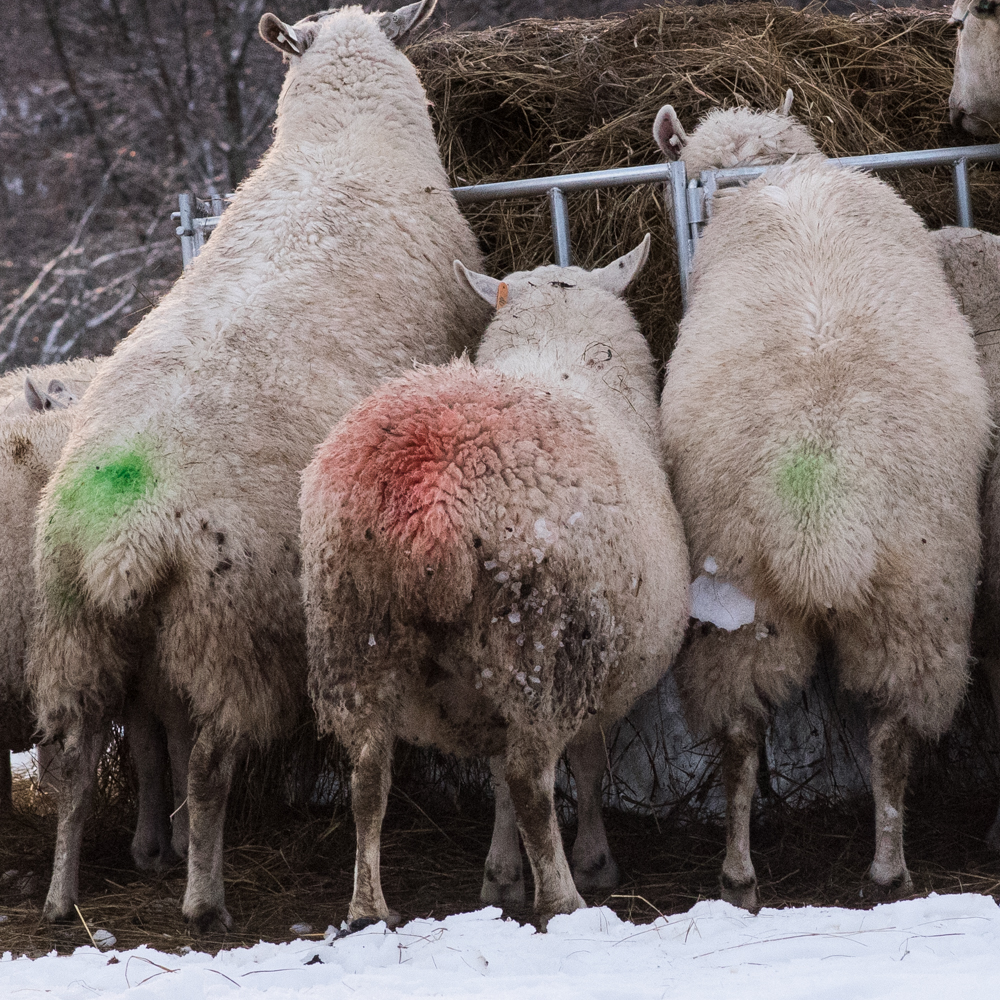
Merry Christmas and all that.
Tagged: bale feeder, breeding, ewes, green butts, Merry Christmas, red butts, snow

Merry Christmas and all that.
Tagged: bale feeder, breeding, ewes, green butts, Merry Christmas, red butts, snow
I’ve been concerned that Mr. Fancy Ram hasn’t been doing his job. He’s been in with the eight dorset ewes since 2 December, and he’s only visibly marked 3 of them. I was hoping that he was continuing to do his job and that his raddle was just fading, not leaving blue marks on the ewes’ butts despite breeding. On Sunday I brought the katahdin group in with the dorsets, hoping that Angus would breed any gals the dorset ram missed. In my perfect world, the two groups would hang out for 17 days, peaceably socializing, while no further breeding occurred. This would tell me that both rams had done their bits, and all ewes were on the way to making lambs. Instead, Angus bred 3 of the dorsets in the first 12 hours, marking their butts emphatically red.
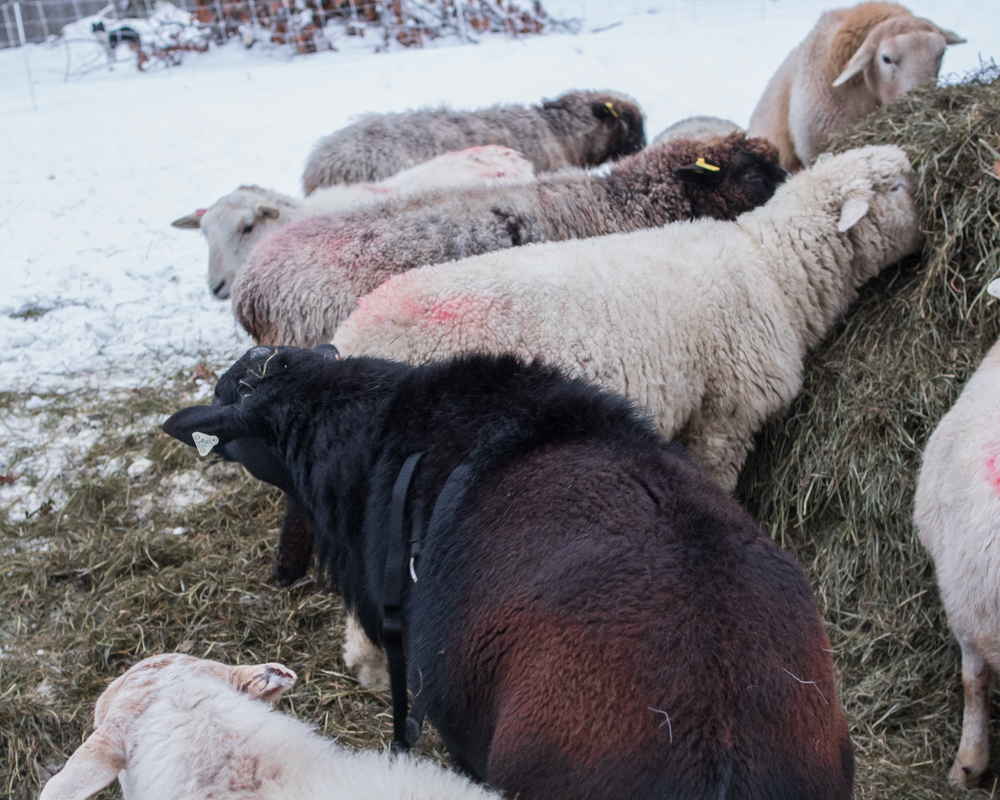
Assuming that this is the first time these ewes have come into heat, the best I can say for the dorset is that he’s not as enthusiastic about his job as Angus. My fear is that they were cycling when he first joined them, and he missed them. The next test will be to see if the ewes with the dorset ram’s blue mark will be re-bred by the katahdin.
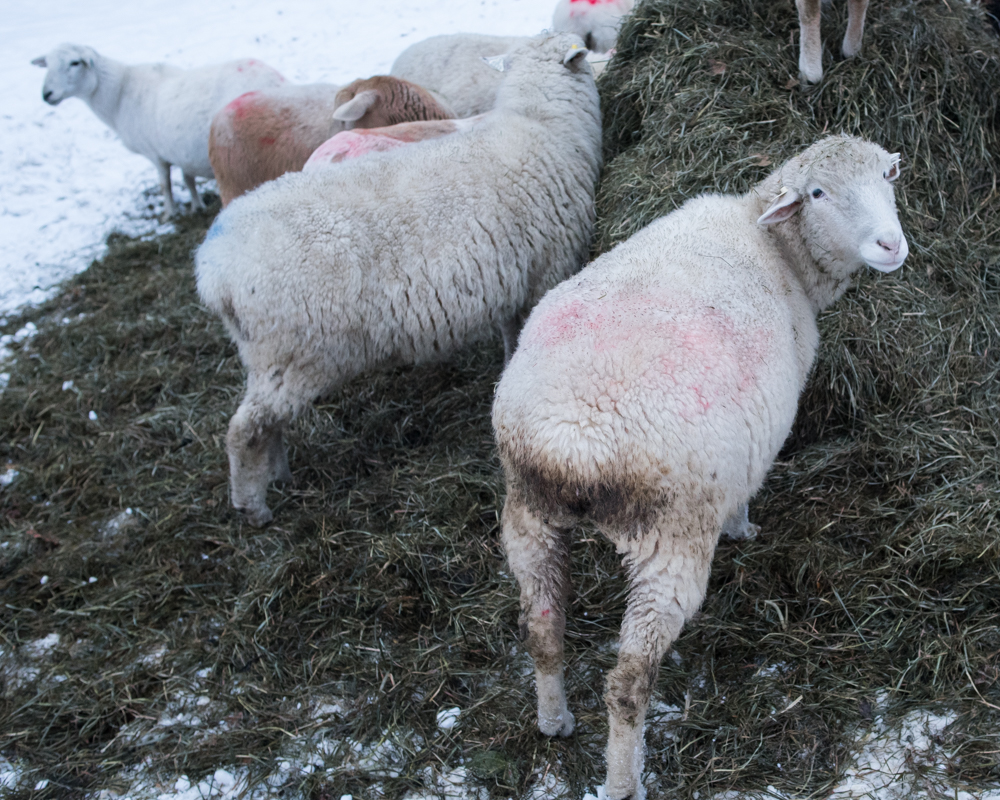
If that happens, Mr. Fancy Ram may be freezer-bound, and I can report back whether $1200 lamb chops taste more bitter than the usual kind.
Tagged: Angus, blue butts, breeding, Dorset, dud, ewes, getting it done, Katahdin, ram, red butts
Five days ago I wrote about my skepticism of raddle powder as a means for marking breeding. I managed to apply more raddle to the young North Country Cheviot ram that day, and the results may turn me into a believer.
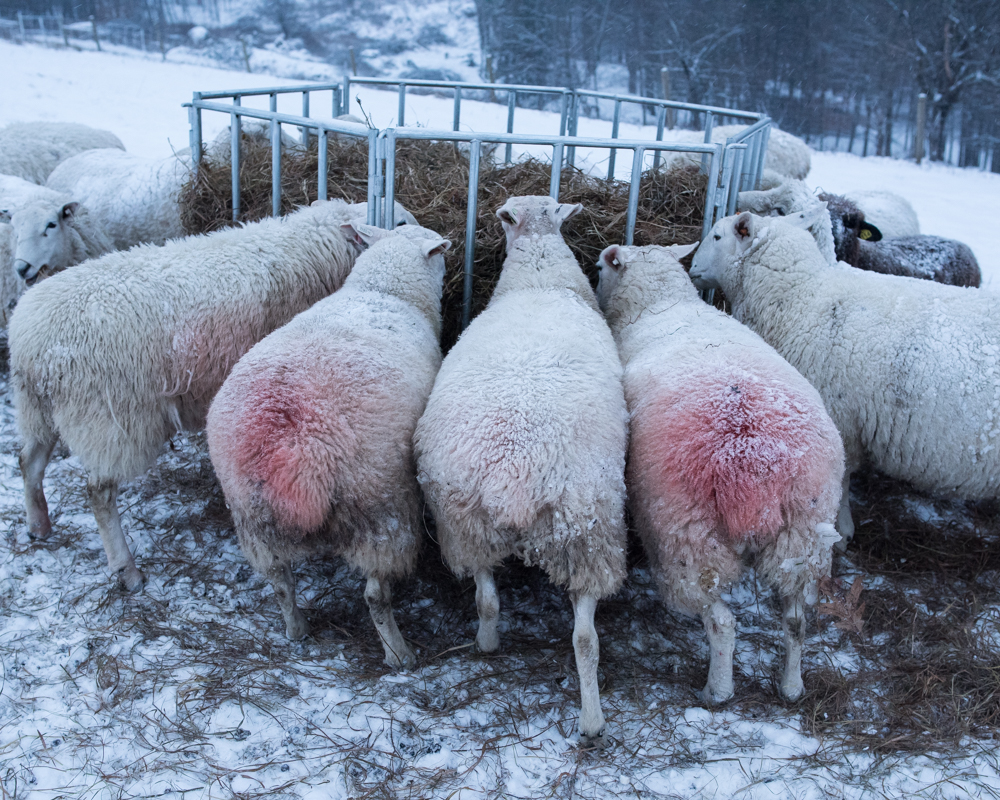
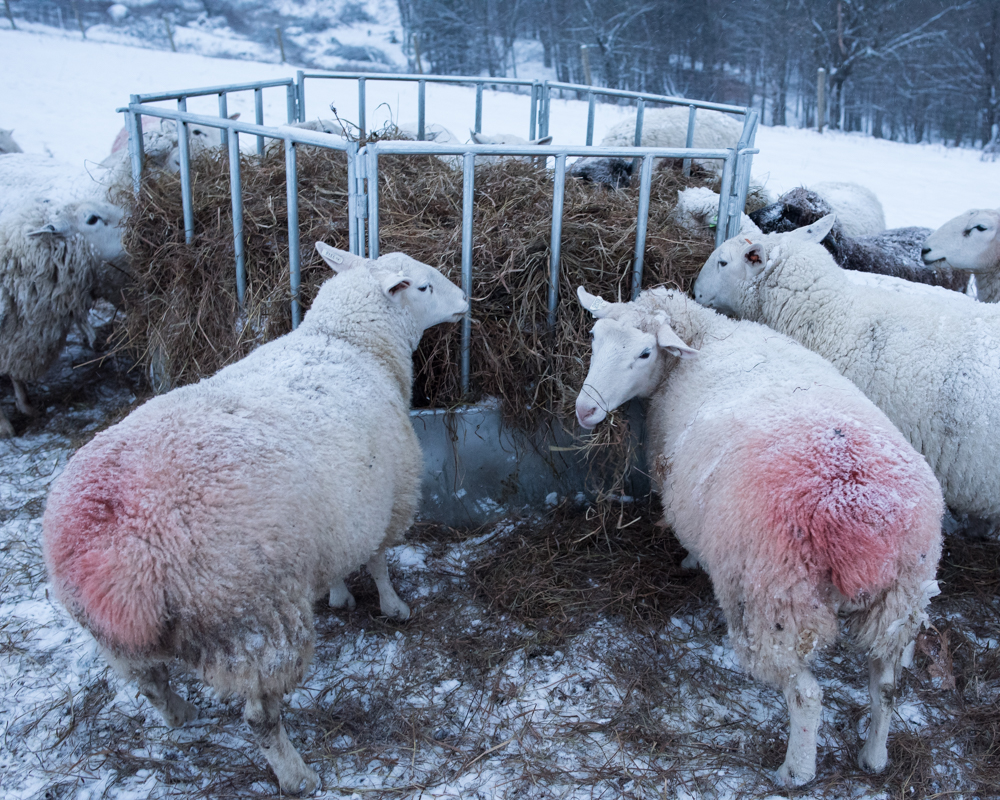
The ram seemed pleased with his handiwork.
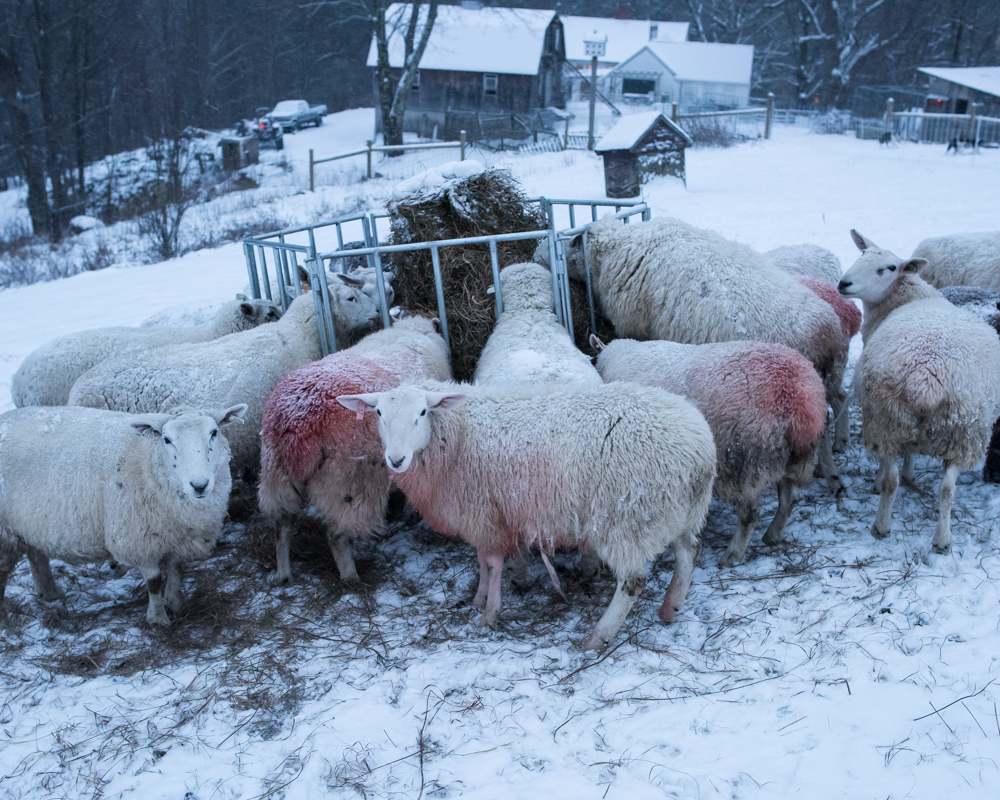
My new conclusion is that raddle creates very clear marks, thank you very much, if you get enough of the damn stuff smeared on the ram. And my concern that the ram lamb might not have been up to the job of breeding his group of 18 ewes seems premature as well. Since the reapplication of raddle, he’s leaving a sea of red butts in his wake.
Tagged: bale feeder, breeding, ewes, marking, north country cheviot, raddle, raddle powder, ram, red butts
Bill’s advice on matters ovine has been close to infallible since I started trying to farm, so when he said he preferred raddle powder to marking harnesses for tracking breeding progress, I took him at his word. He said the one exception was hair sheep, like my katahdins, where a marking harness works better. He advised that the raddle powder needs to be re-applied every few days, but that it was easier than “frigging with a marking harness.” A week into this year’s breeding, my mileage is starting to vary. Angus’s marking harness is staying nicely in place,
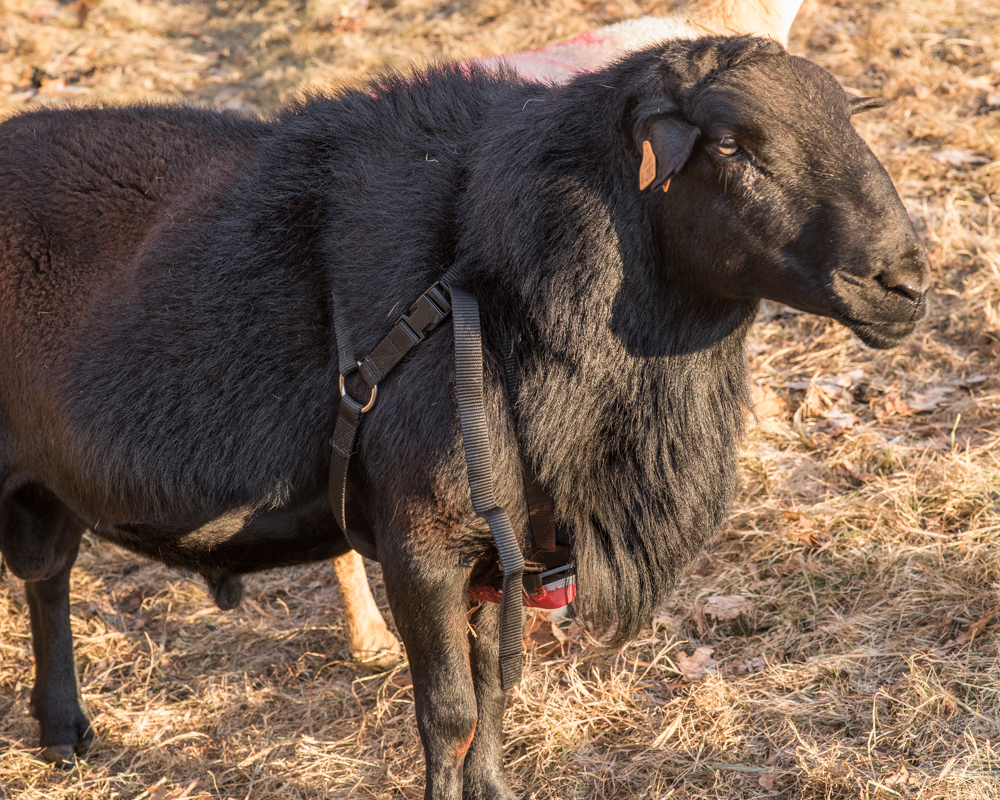
and the marks he’s leaving on the ewes are emphatic and clear.
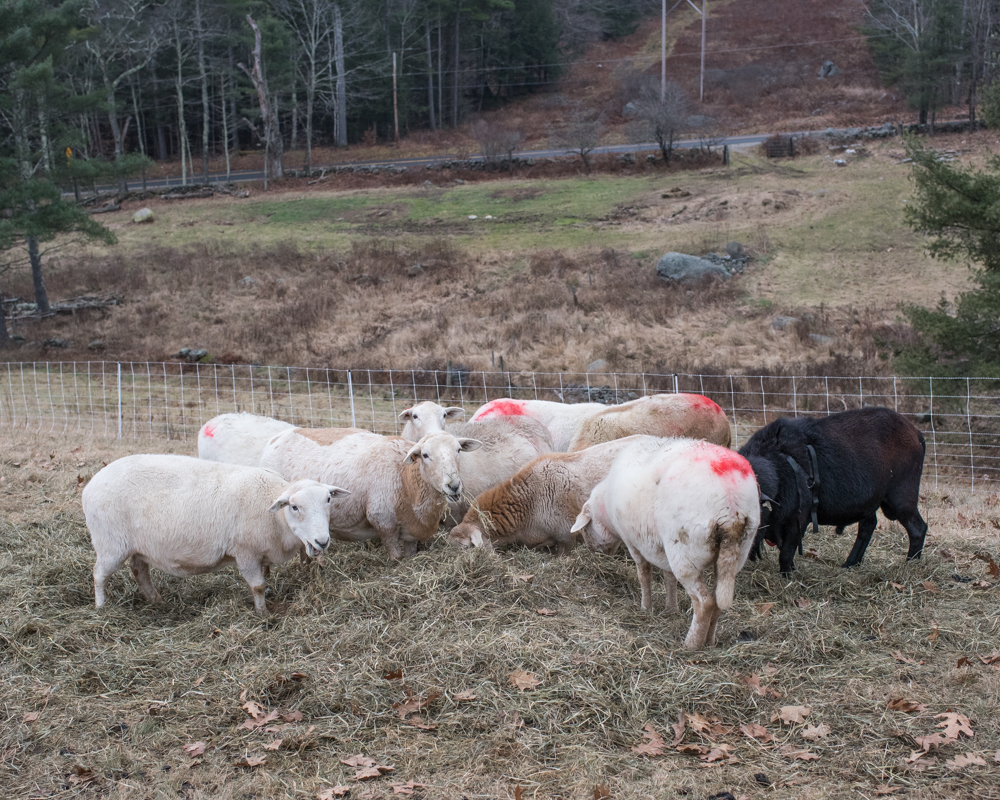
The raddle powder, though, hasn’t been amazing. You can see a bit of it on the North Country Cheviot ram’s chest here, but the mark on the ewe is subtler than I’d prefer.
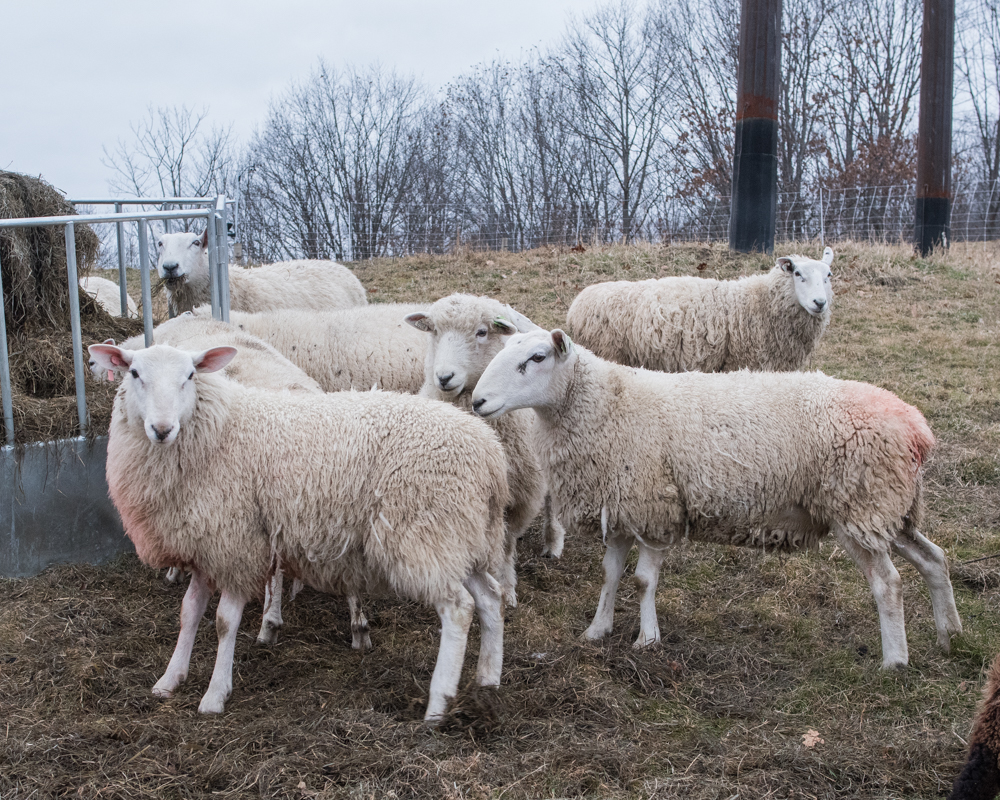
I decided today to try to re-apply raddle on the three wooly rams today, with mixed success. Preparing the stuff is a bit of a mess,
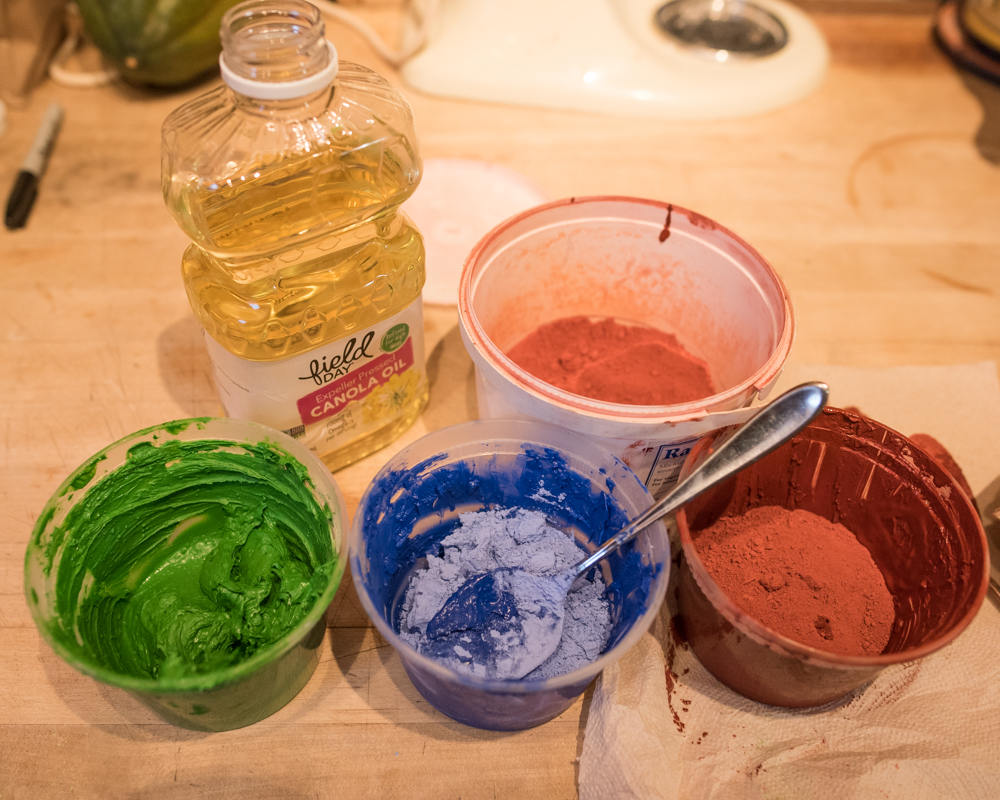
but turned out to be much easier than the next step. I did manage to catch the North Country ram, but he was not enthusiastic about the project. At that point in the afternoon we had about 3 inches of fresh snow in the pasture, and the ram took me for a bit of a ride before I finally got control of him and applied more raddle paste to his chest. I regret that there’s no video evidence of my sleigh ride.
Bill was right that once I had the ram seated in front of me, applying a handful of red paste to his brisket was very straightforward; but I’m not convinced that a properly sized marking harness needs much frigging during the 17 or 34 days that a ram is in with ewes. I’m only 8 days in to this year’s breeding season, though, so there’s still plenty of time to be wrong…
Family life seems to suit my sheep. These katahdins were previously my flightiest sheep, rarely letting me get close enough to touch them, and Angus the ram has always been a fairy imposing fellow. This morning, though, I could hardly keep them off me.

Tagged: Angus, breeding, ewes, family group, friendly, harem, Katahdin, ram, schmoozing, sheep
When the rams first joined their group of ewes, there was some frantic reproductive behavior, but now things have settled down a bit. The current pattern is that a ram will find a girlfriend for the day, and they pal around together, sometimes with blissful smiles. Here’s the 1½-year-old border cheviot with a first-time breeder:
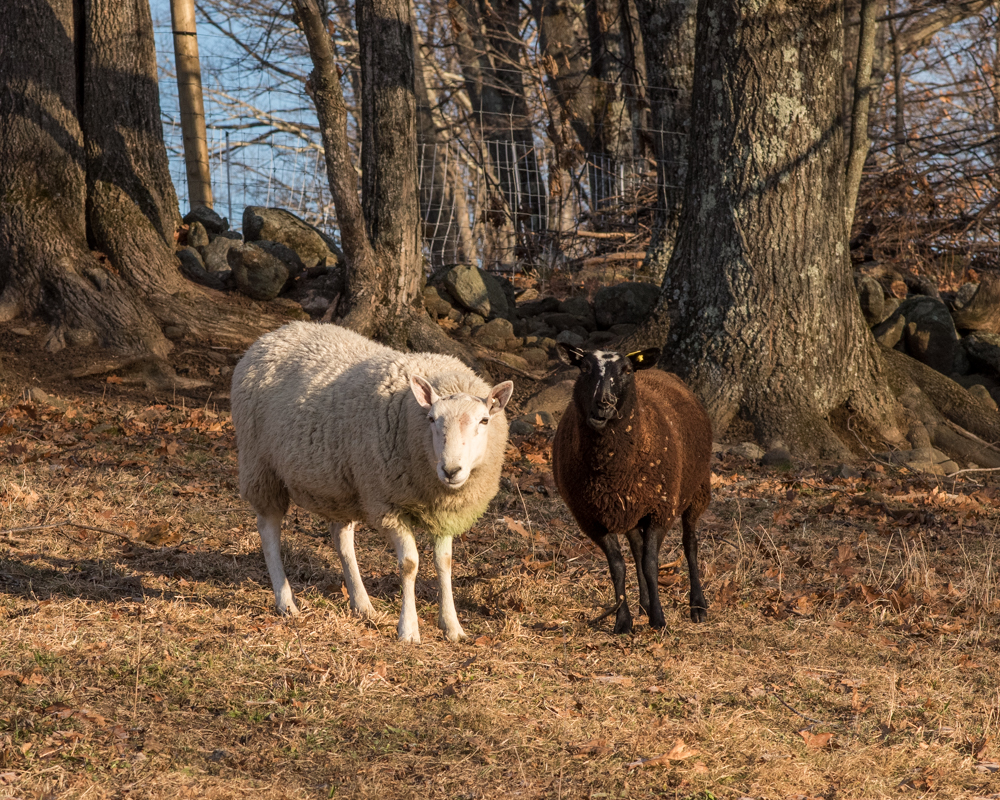
They were off in the tree line while the rest of the group — former girlfriends, judging by the green butts — was hanging around the bale feeder.
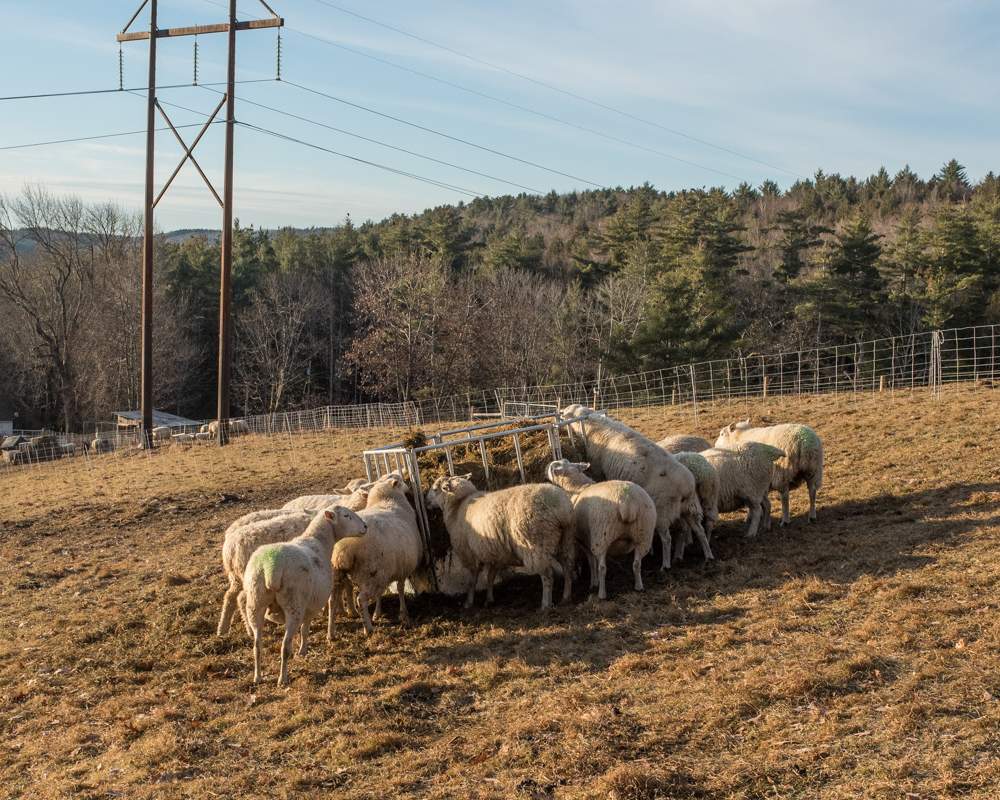
And in the other cheviot group, the 8-month-old ram lamb had paired up with the oldest ewe in the flock.
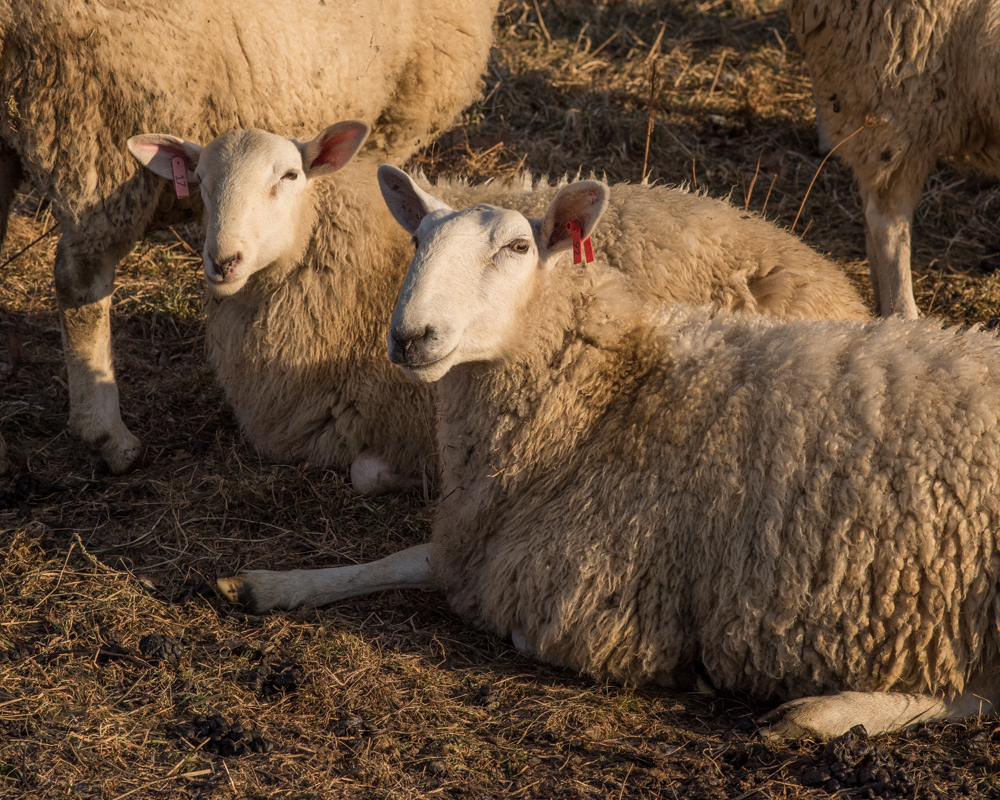
I’m tempted to make a snarky comment about some prominent men (and the women around them) being better off had they been born sheep, but I shan’t.
Tagged: Border Cheviot, breeding, ewe, fugitive loyalty, girlfriend, north country cheviot, ram, smug
Angus, the big katahdin ram, was pretty worked up on the day of the breeding sort. He took a hard shot at Cass as she was starting to move them to the handling system (She yelped, but then inflicted at least as much damage to Angus with her teeth as he had with his skull. That convinced him to defer to her once again.), and Bill was on edge lest Angus knock one of us over the fence. I imagine that all the cheviot-sired lambs, just across the fence from the rams, were ovulating in earnest and his hormones were raging. The good news is that he’s now channeling all that testosterone into more productive activities.

As of this morning, he had bred five of the eight ewes he’s responsible for, and he seems very pleased with his new family status. My 1½ year old border cheviot ram wasn’t acting out to the same extent, but he’s also been busy: 14 of his 27 ewes were marked this morning. The two younger fellows, the dorset and north country cheviot rams, are lagging behind, having bred well fewer than half of their respective harems; I’m hoping they become a bit more efficient, but I’m afraid they’ve missed their opportunity with some of the ewes. The fact that the two older rams have bred so many suggests that more than half of the ewes were cycling in synchrony, so the youngsters won’t get another crack before I combine the ewes with all the rams for cleanup duty during the second ovulation cycle.
Over the course of the year, I’ve often fought with my anthropomorphic tendencies, e.g. here and here. Usually this takes the form of imputing human characteristics onto my animals, but the breeding dynamics suggest that the anthropomorphic arrow may have two heads. I would love to take the rams’ performance as evidence that older men are inherently superior to younger ones, but I can’t imagine anyone taking me seriously. Oh well.
Tagged: Angus, anthropomorphism, Border Cheviot, breeding, cycling, Dorset, efficiency, ewes, harem, Katahdin, marking harness, north country cheviot, older men, ovulation, rams, red butts
Bill came over today to help me sort my flock into breeding groups. We brought the lambs and the main flock into the handling system and started by sorting out everyone who wasn’t going to participate — wethers,* ewe lambs, and ewes who were too small to breed — and sent them out to the back field. We sorted the remaining flock, 61 ewes, into groups for each of the four rams, and sent them to separate enclosures so that the rams would stay with the ewes we’d chosen for them. Here are the four groups, and some of the logic behind them:
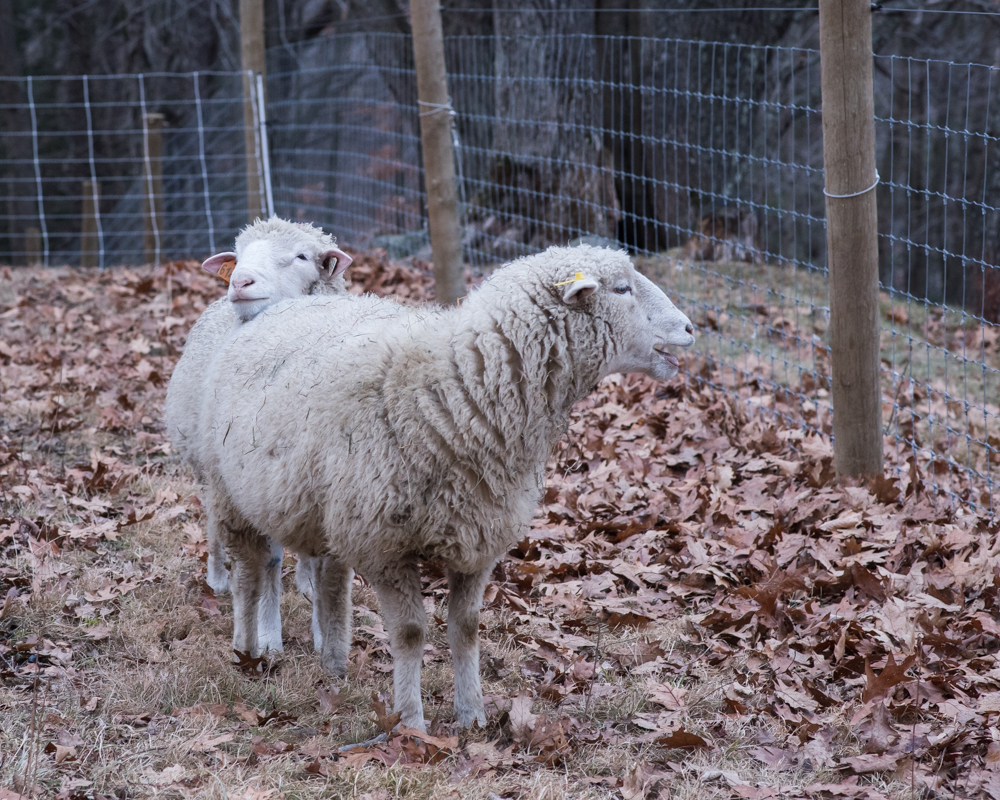
One of the tricks to the breeding game is to use a marker on the ram so it’s possible to tell which ewes have been bred. The traditional tool is something called raddle, a colored powder that you mix with oil and rub on the ram’s brisket. When he mounts a ewe, he leaves some of his color on her backside, proof of intent but not necessarily success.
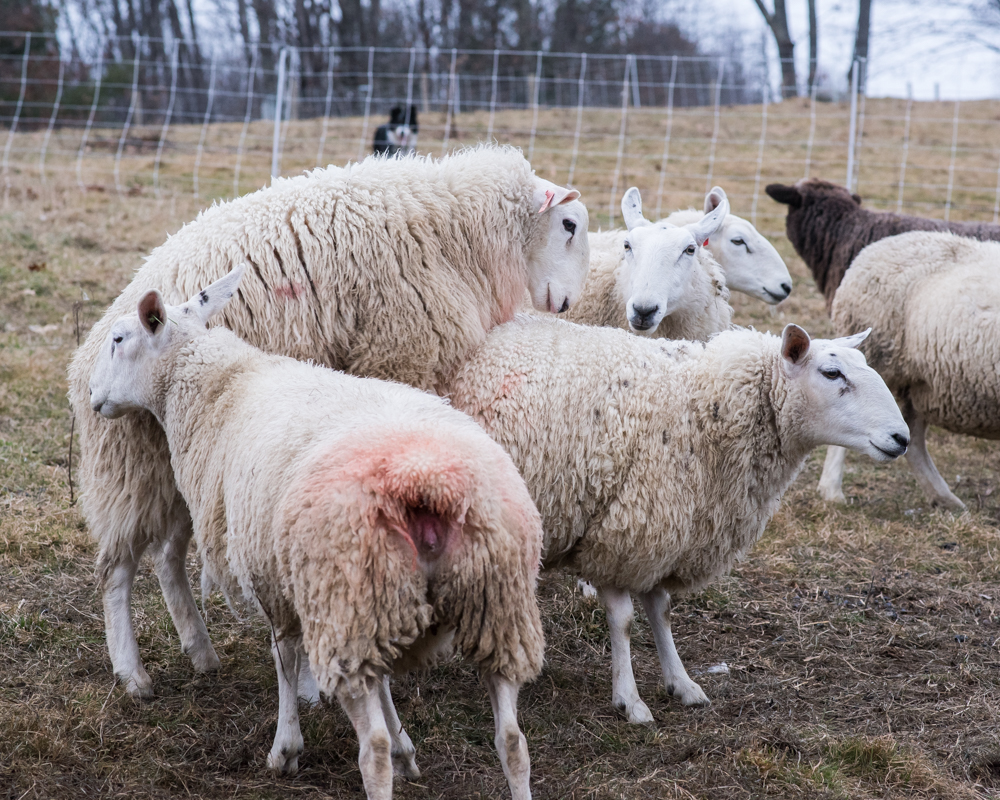
I’m using different colors for different rams at the moment.

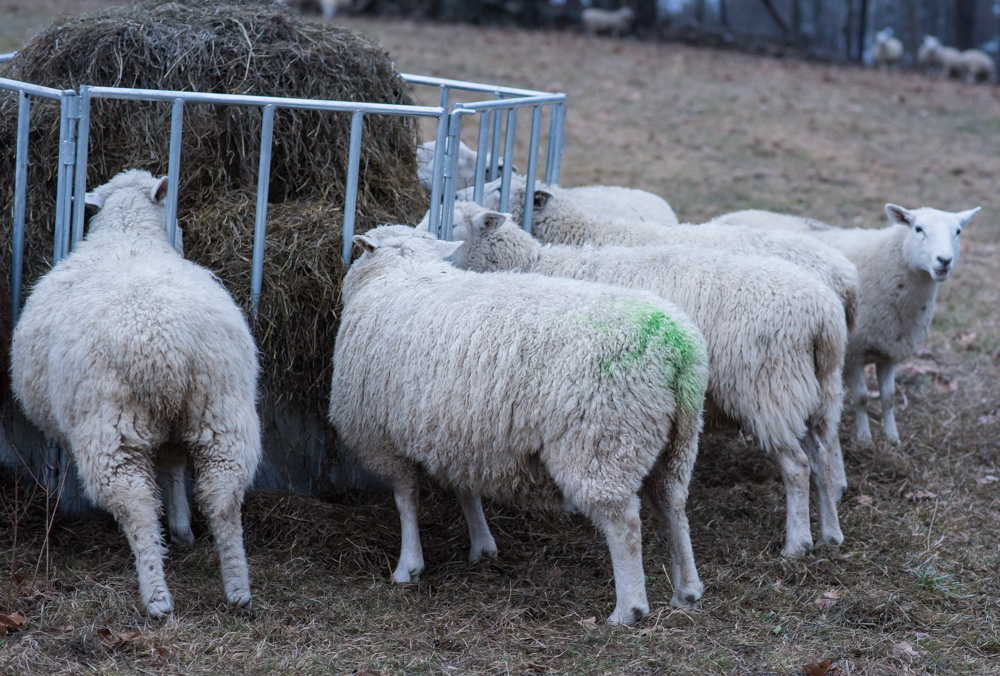
After 17 days, during which time the ewes should all have ovulated once, I’ll mix up the groups, letting all the rams consort with all the ewes. If a ewe ends up with a second color, it means that the first ram didn’t do his job, since she’s still ovulating.*** My preference is to have all my lambs in as short a time window as possible, so I hope all four rams do their jobs during the first ovulation cycle, but late lambs are better than open ewes.****
* Wethers are castrated male sheep.
** North Country cheviots are generally bigger than romneys (150-170lb ewes vs 110-130lbs), but crossing 2 pure breeds also creates something called hybrid vigor, so I’m hoping for faster-growing and bigger lambs than the North Country contribution alone would account for.
*** A ewe will only allow a ram to mount when she’s ovulating, so a ewe who is marked by a second ram has ovulated again, and therefore was not impregnated by the first ram.
**** An open ewe is one who is not pregnant.
Tagged: Border Cheviot, breeding, Dorset, ewes, heterosis, hybrid vigor, Katahdin, kilts, marking harness, North Country checiot, raddle powder, rams, sorting, zippers
Today I’m thankful for my rams (and many other things besides!), who spend most of the year on less-than-perfect pasture, patiently waiting for the month when they get to make lambs. This year’s breeding is scheduled to start a week from tomorrow, and I will be writing more about all the head-scratching I’ve done, alone and with Bill, to figure out who gets bred to whom. I’m still figuring out the logistics of it all. In the meantime, I present Angus the Katahdin for your enjoyment.
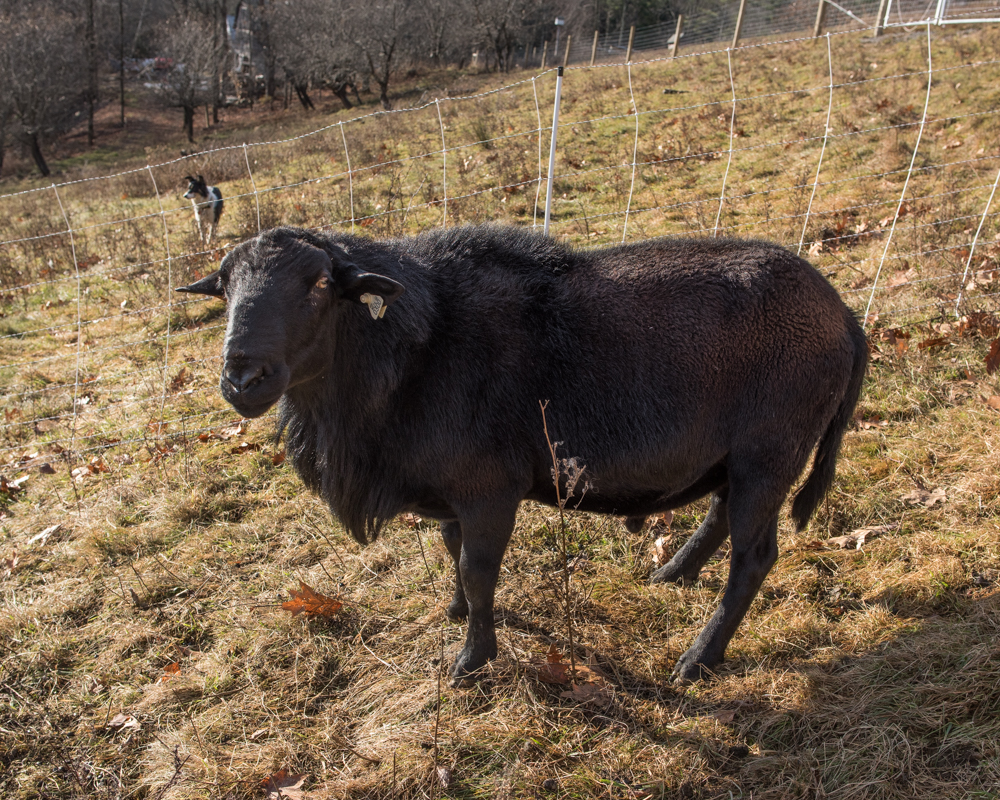
More than one visitor to the farm has audibly gasped when they see him. While fluffy white sheep are regularly invoked as stand-ins for God’s chosen people, Angus looks like the mascot for the other team.
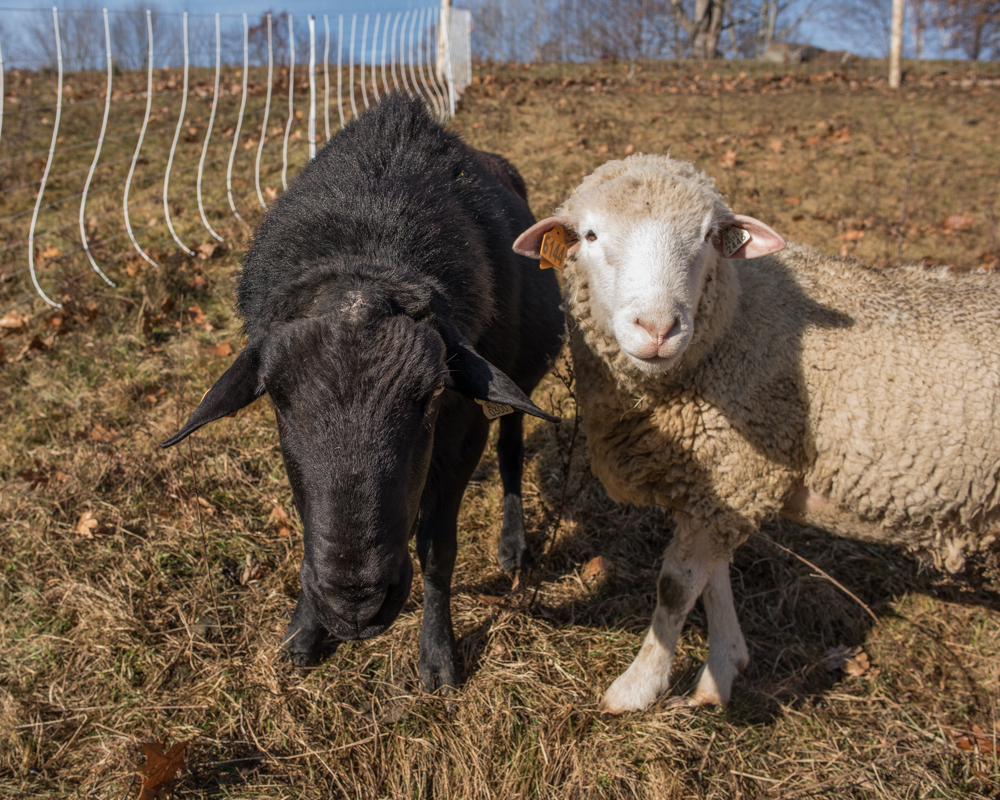
His job is to bring some size to my Katahdin flock. The ewes have lots to recommend them — easy lambing, good mothering skills, ostensible parasite resistance (still confirming that bit), and no need for shearing. Katadhins’ dammit feature is that their lambs grow slowly to a final size that’s not very impressive. I’d love to keep this breed as part of my flock, but if their lambs only reach 60lbs at market time — I’d prefer 110, but would take 90 — their other qualities won’t carry the day. Angus weighs almost 190lbs, and I’m hoping some of that finds its way into his offspring.
This is a blue-gray gnatcatcher. And here’s a recording of his call notes: There’s a robin singing in the background; the gnatcatcher’s vocalizations are the worried-sounding scolds. So he’s not the fanciest or most attention-getting bird around. He weighs around 6 grams, hangs out in treetops, moving constantly, and can’t sing worth a damn (from a biased, robin-centric standpoint), but he’s actually a fairly common bird. Once you tune in to his vocalizations, you start to notice gnatcatchers all around, especially in wet woods. Since this spring’s migration started in earnest a couple of weeks ago, I scarcely remember a walk we’ve taken when I haven’t heard at least one gnatcatcher. The problem is that, until recently, I had no…
Tagged: bird, Blue Hills Reservation, Blue-gray gnatcatcher, breeding, Fowl Meadow, lichen, nest, spring